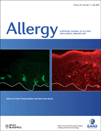Basal serum tryptase as risk assessment for severe Hymenoptera sting reactions in elderly
Abstract
To cite this article: Guenova E, Volz T, Eichner M, Hoetzenecker W, Caroli U, Griesinger G, Burow G, Mitev V, Biedermann T. Basal serum tryptase as risk assessment for severe Hymenoptera sting reactions in elderly. Allergy 2010; 65: 919–923.
Background: Epidemiologic studies suggest that elderly people are more prone to develop severe anaphylactic reactions. However, the exact cause for this phenomenon remains unclear.
Aims of the study: To study the role of the serum tryptase as a diagnostic parameter for individual risk evaluation and its impact on the severity of allergic reactions in elderly people.
Methods: Two hundred and seventy-four consecutive patients visiting the Department of Dermatology, Tübingen, Germany, who were diagnosed with honeybee or wasp venom allergy, were included in the study.
Results: Sting reaction severity increased with increased age and tryptase levels (P = 0.001 and P = 0.0003, respectively). Furthermore, we find not only a general increment in tryptase levels in elderly people (P = 0.0001) but also a continuous increase in tryptase concentrations even below the cut-off (11.4 μg/l) with increasing age (P = 0.0026).
Conclusions: Our data confirm serum tryptase as a risk factor for severe anaphylactic reaction to hymenoptera stings. Furthermore, we give first evidence that basal serum tryptase levels increase continuously with age and being an indicator for either increased mast cell load or reactivity this can at least partly be responsible for the observed aggravated allergic reactions in elderly people. As those patients are at increased risk for life-threatening anaphylactic reactions, it should be considered to adjust VIT especially in elderly patients with elevated tryptase levels as recommended for patients with mastocytosis by increasing venom doses during VIT and by considering its life-long continuation.




